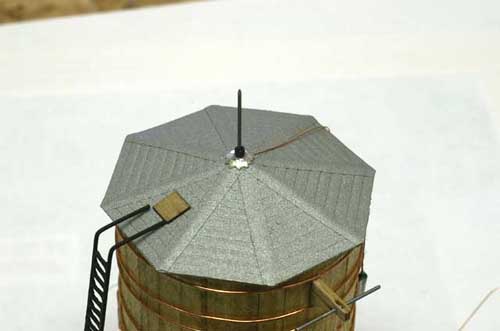|
|
|
 |
|
|
|
|
 |
|
The width of the slats of the water tower side and the leg assembly were determined by a thickness of the piece of wood used for the construction. All pieces were cut with an electric compound mitre saw. The support structure was built first, then the tank. The tank is hollow, with a circular piece of card stock top and bottom.
Top left: In this view you can see the superstructure and a profile of the water tower. The thin copper wire extending to the right, and down the right side of the structure, is the ground wire. It attaches to the lightning rod at the top of the tower and will attach to a ground rod when placed on the layout. Note the water level indicator with the marker on the front right of the tower. The position of the marker is fixed, it does not move. The water spout does move, and is almost down. Note the position of the counter balance.
Top right: In this view, the spout is up. Note the position of the counter balance. A 'rope' is tied around the 'boulder', goes up through a tiny hole in the stand-off, passes of the metal rod, and then down through anoth tiny hole and attaches to the water spout. The counter balance is just the right weight to offset the weight of the spout. A good view of the ladder is seen in the picture. The ladder is constructed from a piece of piano wire. The rungs of the ladder were cut from the piano wire stock also and glued in place. No jig was used in the construction of the ladder. The n-scale figure and the penny are included for a size comparison.
Bottom: This picture shows the detail of the room construction, as well as the top of the standoff that supports the spout and county weight. Stiff card stock was used to make a template for the roof structure. Once the proper size of the triangular sections was determined, the actual roof panels were cut from a thin piece of wood. The 'roof slats' were created by layering thin pieces of striping tape to get the proper depth. The cap overlaying the junctions were the roof sections come together were created the same way.
Back to site map
Page last updated 2/2/2006